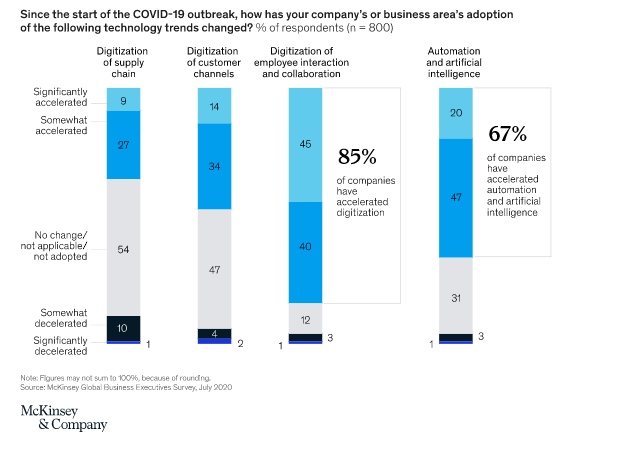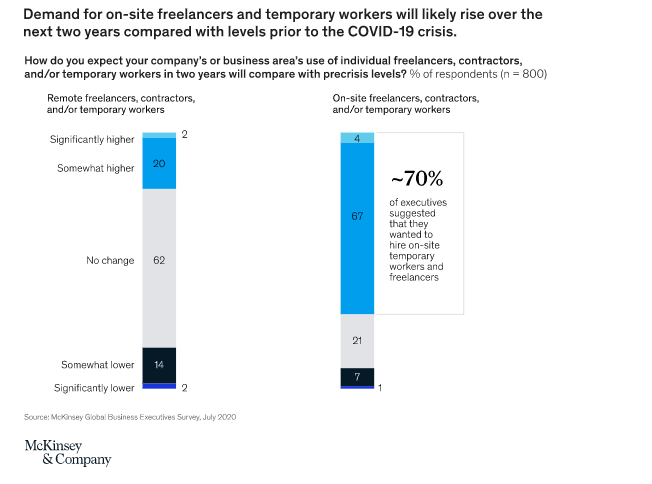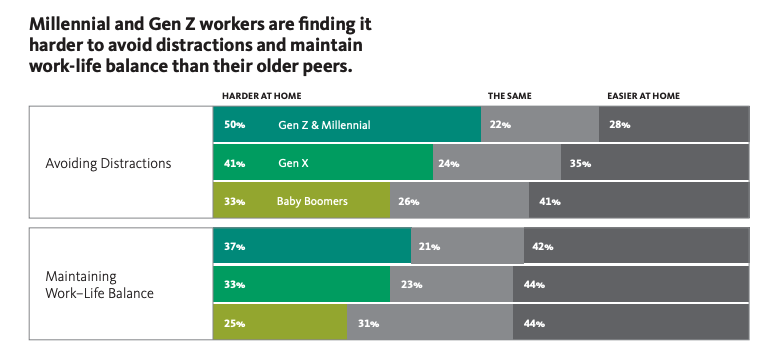This Is The Future of the Digital Workplace


While many of us are returning to the workplace, there’s no going back to the way things were before the pandemic.
Some of the changes we’re seeing now had already been in motion; the events of the past year simply accelerated them. That includes the adoption of digital workplace technologies.
McKinsey surveyed 800 global executives to determine how they’re responding. While there is no universal playbook for recovery, these findings can help inform your future digital transformation strategy and technology investments.
How are companies approaching technology in the digital workplace?
The pandemic has overwhelmingly been a catalyst for the adoption of more digital solutions.
The reasons for these investments are multi-faceted, but the greatest motivation has been a desire to improve productivity.
A stunning 85% of companies reported they accelerated digitization to enable better employee interaction and collaboration, according to McKinsey’s research.
Sixty-seven percent said they moved faster to implement automation and artificial intelligence.
Additionally, 48% of companies said they adopted digital technology to improve the customer experience, while 36% said they did so to improve their supply chain.

What new digital technologies are companies adopting?
Perhaps not surprisingly, the most popular digital workplace technologies include virtual meeting tools, filesharing, and other cloud-based solutions designed to improve collaboration and employee engagement.
Companies have also adopted more mobile apps and chatbots to improve customer service.
And when it comes to increasing operational efficiency, autonomous and AI-powered technologies are leading the way. That includes robots to assemble products, assist in warehouses and distribution centers, and keep facilities clean.
Moving more customer-facing operations online is another major shift.
When it comes to implementing new solutions in the digital workplace, the finance and tech industries appear to be ahead of the curve. Eighty-eight percent of finance and insurance executives and 76% of IT executives reported an increase in these solutions since the pandemic began.
How have attitudes toward remote work changed?
Prior to the pandemic, only 8% of executives globally said their employees could work remotely two or more days a week. Amid the pandemic, that percentage almost doubled to 15%, according to McKinsey’s research.
Attitudes toward remote work vary by country and industry. For instance, 20% of executives in the UK and Germany said they would allow at least a tenth of their employees to work remotely two or more days a week. In China, that number dropped to just 4%.
The research also found jobs in IT, finance, insurance, and management seem to have the greatest potential for remote work compared to other positions.
Several leading technology companies, including Facebook, Twitter, Shopify, and Slack, have announced they are revisiting their policies to allow for more remote work in the future.
However, they are still the exceptions rather than the norm.
Research by Gensler found 70% of employees still want to work in the office for the majority of their week, while only 12% want to work from home permanently.
At the same time, companies are increasing their reliance on agile talent to supplement their full-time workforce. This allows them to tap into the growing gig economy and hire from a more diverse, geographically distributed pool of applicants.
Twenty percent of executives who responded to the McKinsey survey said they expected their use of remote freelancers and contractors to be somewhat higher over the next two years.

How will companies help employees succeed in the digital workplace?
When it comes to how employees feel about the increasingly digital workplace, there’s a wide spectrum. Some employees are technology laggards, while others are early adopters.
There are also differences in how each generation uses workplace technology.
Many Millennials and Generation Z employees prefer to consume information on their own time and communicate through text or chat, while Baby Boomers tend to prefer more face-to-face conversations. New technologies may be less intuitive for them, but that doesn’t mean they aren’t comfortable using them.
Younger generations can take lessons from Baby Boomers and Gen X when it comes to shutting out technology distractions and maintaining a better work-life balance.
Half of Gen Z and Millennials said it was harder to avoid distractions at home, compared to 41% of Gen X and 33% of Baby Boomers, according to Gensler’s research.

To help all generations be more productive in the digital workplace, 45% of executives who responded to McKinsey’s survey said they planned to hire more people to support digital learning and agile ways of working.
What does this mean for your organization?
We’ve reached a pivotal moment where the work environment is no longer defined by four walls. This change was inevitable, but the pandemic has forced many of us to adopt new business models sooner if we want to stay relevant.
To thrive beyond the physical workplace, your company needs to accelerate its digital transformation journey. The longer you wait to make changes, the farther behind you will fall.
Here are three steps you can take now.
1. Conduct a SWOT analysis
Take an honest look at your strengths, weaknesses, opportunities, and threats when it comes to workplace technology.
This is a good time to assess the technologies you have now, how well they’re serving your workforce, and what new solutions you may need to fill the gaps.
For instance, if the majority of your software systems are built on-premise but a significant percentage of your employees plan to continue working remotely, they won’t be able to access them without a virtual private network. You will need to consider better ways to allow them to access the data and workflows they need.
You also need to consider how advanced your solutions are when it comes to collecting workplace data, reporting on it, and using it to continually optimize your environment.
To conduct a SWOT analysis for digital transformation, start with these 10 questions.
2. Simplify your technology stack where possible.
Many enterprises are overwhelmed by too many different technologies. You may have acquired several companies in recent years and inherited the legacy systems they were using. Or, department managers may have purchased single-point solutions that were never widely adopted across your organization.
This is both inefficient and expensive, especially if you’re paying licensing fees for solutions your workforce rarely uses.
Consider McKesson, a global healthcare company that was using nearly 60 different applications to manage its workplace. This made it nearly impossible to find a single source of reliable data and gain alignment between the facilities management, HR and IT departments. It also meant there was no consistent user experience across all locations. Employees might use three different business applications when traveling between different locations.
Implementing iOFFICE’s cloud-based workplace technology allowed the organization to improve data quality, streamline operations and improve the employee experience.
3. Invest in mobile technology
If the pandemic has taught us anything, it’s that many of us have the ability to work anywhere. However, even employees who are fully remote need to feel a sense of connection to each other and to your company’s larger goals.
One way to do that is to invest in technology that meets them where they are.
That includes mobile apps that help employees reserve space in advance or at a moment’s notice, navigate their environment, easily find colleagues and get help when they need it. They should also be able to receive important announcements, such as notification if they may have been exposed to someone who tested positive for the coronavirus.
A workplace app like iOFFICE Hummingbird gives your workforce everything they need to be productive from anywhere, while giving you valuable data to help you plan ahead.
When you use it along with our next-generation workplace software, known as iXMS, you can strategically plan your space, monitor utilization trends, and make adjustments in real time. You can also manage important services that keep your employees safe, such as wellness checks, contact tracing, and frequent sanitization.
While many of the changes we’ve seen in the past year may be permanent, the potential to expand to a truly global, digital workplace is exciting. Although no one could have predicted something as disruptive as the coronavirus would be a catalyst for digital transformation. we’ve been preparing for this shift for years.
If you’re ready to talk about how we can help you achieve a new level of connection and productivity in your digital workplace, schedule a 15-minute call with us.
